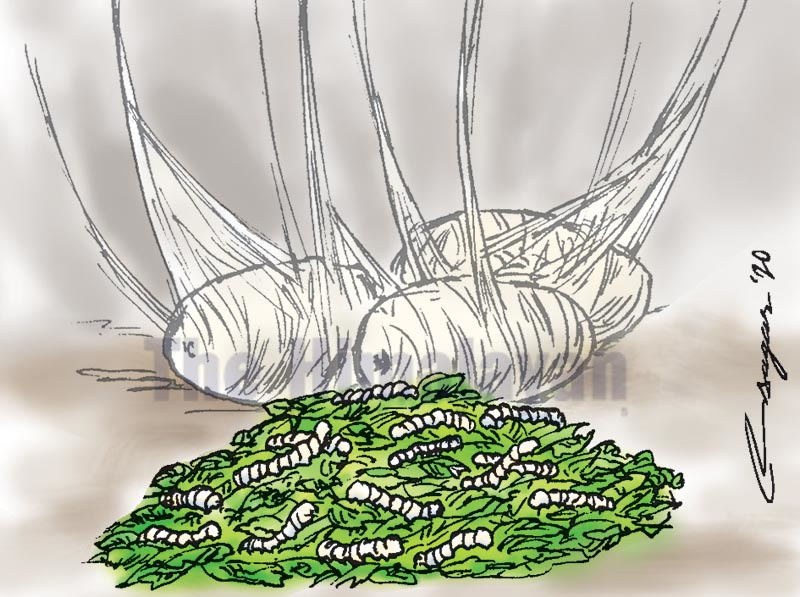The silk perestroika: A stupendous challenge for science
Research is resourcefully on to tapping and inserting a synthetic gene, or bacteria, to achieving a sublime objective — duplicating the biochemistry of silk and the spider’s ‘psyche’. This foray will substantially increase the stability of its proteins
Silk is Mother Nature’s extraordinary, also astounding, creation — more so, because the little spider, by a biological happenstance, was given the talent to making silk, a fabric like no other. As Robert Boyle, the renowned Anglo-Irish natural philosopher, chemist, physicist and inventor, extolled, we are beholden to the petite caterpillar for silk, just as the little ant-hill motivated King Solomon’s transcendent thought that turned his horse away and his troops followed in agreement — so as not to decimate the tiny living creatures along the route.
The moment this wonderful thing happened, the Queen of Sheba affirmed, to paraphrase: “Oh, wise king, your people are, indeed, happy and contented.
I’ll always remember the exemplar. He only is honourable and great who has empathy for the helpless and weak.”
It’s perhaps apt, in the context, to hark back on the fascinating ancient parable of Archane, a brilliant earthly weaver, who threw down the gauntlet at Athena, the goddess of wisdom and the arts, sans ado. Predictably, Athena’s curse metamorphosed Archane, and her surplus pride, into a spider. The allegory illustrates that it is to the self-effacing spider that we owe the first evidence for weaving cloth. As contemporary philosophy academics, David Werther and Mark Linville, enlighten, every enigmatic thought in a religiously noteworthy sense is best interpreted as a kind of gratitude, knowledge, or ‘connect’ with a fellow being, as also what silk always feels like.
When the ‘Tiger of Mysore’, Tipu Sultan (1750- 1799), pioneered the silk perestroika, he may not have, perhaps, envisioned that science would one day warp the fundamentals.
That is, synthesise the exquisite silk fabric of the future for mass consumption — right from protective clothing, bulletproof jackets and trappings to a ‘diamond’ for one coveted cricket World Cup trophy.
Or, something that would give the miracle weave a new tag — one that could be used as the most durable, also ideal, material in the manufacture of specialised items, viz., parachute cords, synthetic tendons, zero allergy sutures, implants, ‘synthetic’ skin and, most importantly, silk (protein) ‘fixes’ to mend damaged hearts.
For certain folks who may not believe in silky metaphors, they may have to, thanks to noted arachnologist Theodore Savory’s enlightened aphorism, “Silk is the warp and woof of the spider’s life.” It simply means this — from their birth to death, the existence of every spider depends on silk, like every steadfast soldier’s calling to protecting their homeland and its people. This is a noble aphorism that exists in sharp contrast to the troubled times we now live — a world of frenzied upheaval, chaos, hatred and mayhem.
It is agreed and also accepted that a host of earlier endeavours to mass produce silk were big letdowns.
The fact, however, is this — it was not because silk has far too unique properties and untapped potential, or value, but because there’s more to it than what meets the eye. Silk is softer than cotton and stronger than iron; it can withstand greater weights than a cable made of steel. What makes it a novel, also legendary, puzzle is its capability to compensate for the most tempestuous windstorm — by stretching almost 50 per cent longer than its original length. This is because silk is basically a composite material made up of crystals embedded in a matrix.
It can contract — a mechanism which reduces the surface area of the web exposed to the dew, or mist.
This is its classy certitude, too. It enables the encumbrance of moisture to be absorbed by the web structure without collapse.
What’s more, the temperature at which the silk fibre becomes delicate, or breaks, is awfully low, thanks to its ‘glass transition’ temperature.
While research, especially in the West, has made much headway today in understanding the genetic blueprint of the silk protein, there’s more to silk than silk painting and/or what meets its statistical fact file.
A single spider can provide more than a hundred feet of silk at a single ‘silking’, following which it needs a break — to replenish its silk supply. This highlights a primal philosophical facet — there is, as a norm, a limited number of ‘action replays’ because of the spider’s comparatively short life-span.
Hence, research is resourcefully on to tapping and inserting a synthetic gene, or bacteria, to achieving a sublime objective — duplicating the biochemistry of silk and the spider’s ‘psyche’. This foray is believed to, perforce, substantially increase the stability of its proteins, while eliminating certain structural disparities between the synthetic and natural protein and, most importantly, speeding up their production.
Is this going against the fundamental laws of nature or transducing their whole purport, you may well ask, if you are the green-centric type. You may also dub the idea, likewise, as a game-changer, if you are the all-for-technology proponent — although the fact remains that silk is nature at its best. The paradox is apparent. Whatever your stand, the whole idea, or ‘perestroika-in waiting’ is a stupendous challenge for science — not just for the much hyped ‘spider inspired’ wonder, but also for the high tech, silky ‘Revolution Next’ to come of age.
The writer is a wellness physician, independent researcher and author






